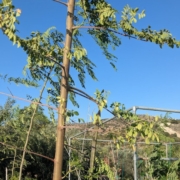Moringa Oleifera, commonly known as the “miracle tree,” is gaining worldwide recognition for its amazing health benefits. Native to parts of Africa and Asia, this tree is revered for its nutritional value and medicinal properties. Moringa’s nickname stems from the fact that nearly every part of the plant—leaves, seeds, pods, and roots—can be used for health purposes. But why is Moringa considered such a powerful plant? Let’s explore its rich background, nutritional value, and numerous health benefits.
Historical Background
Moringa Oleifera originated in the foothills of the Himalayas in Northern India. However, it’s now widely cultivated in tropical and subtropical regions all over the world, particularly in Africa, Asia, and Latin America. For centuries, it has been utilized in Ayurvedic medicine, which claims that Moringa can prevent and cure over 300 different diseases. From the ancient Egyptians to modern-day nutritionists, Moringa has been celebrated for its extraordinary uses and benefits.
Different cultures have used Moringa in unique ways. In India, it has been used as a food source and for medicinal purposes for over 4,000 years. African cultures praise it for its nutritional richness, especially in regions affected by malnutrition. It is also popular in the Philippines and Thailand, where it is added to soups and stews to enhance flavor and nutrition.
Nutritional Profile of Moringa
One of the most astounding features of Moringa is its dense nutritional profile. Moringa leaves are packed with essential vitamins and minerals, including:
- Vitamin A: Important for vision and immune function.
- Vitamin C: A powerful antioxidant that supports immune health.
- Calcium: For strong bones and teeth.
- Iron: Helps combat anemia and boosts energy levels.
- Magnesium: Vital for nerve and muscle function.
When you compare Moringa to other well-known superfoods like kale, spinach, or matcha, Moringa holds its own. In fact, it has seven times more vitamin C than oranges, four times more calcium than milk, and three times more iron than spinach. This makes Moringa an outstanding supplement for anyone looking to boost their nutrient intake.

Health Benefits of Moringa
Moringa’s high concentration of vitamins A and C makes it a fantastic immune booster. Regular consumption can help fend off common infections and diseases, thanks to its antiviral, antifungal, and antibacterial properties.
Chronic inflammation is linked to many serious health conditions, including heart disease and cancer. Moringa contains powerful anti-inflammatory compounds that can help reduce inflammation in the body. This makes it a potential natural remedy for conditions like arthritis or asthma.
Moringa is loaded with antioxidants like quercetin and chlorogenic acid, which protect the body from oxidative stress caused by free radicals. These antioxidants may lower your risk of chronic diseases and slow down the aging process.
Moringa is commonly used in beauty and skincare products because of its hydrating and rejuvenating properties. Its high vitamin E content supports skin elasticity and fights off signs of aging, such as wrinkles and fine lines.
Rich in proteins, vitamins, and minerals, Moringa strengthens hair, reduces dandruff, and promotes healthy scalp conditions. It’s often used in hair oils and shampoos to encourage hair growth and prevent hair loss.
Growing and Harvesting Moringa
Moringa can be grown easily in warm climates. All you need is well-drained soil, ample sunlight, and regular watering. Moringa is a fast-growing plant that can be harvested multiple times a year.
The best time to harvest Moringa leaves is when they are young and tender. To retain its nutritional value, it’s important to dry the leaves in a cool, shaded area and store them in an airtight container.
Conclusion
Moringa Oleifera truly lives up to its reputation as a “miracle tree.” Its rich nutritional profile, combined with a wide range of health benefits—from immune support to heart health—makes it a powerful addition to anyone’s diet or wellness routine. Whether you’re looking to boost your energy, improve your skin, or manage weight, Moringa offers a natural, effective solution.




